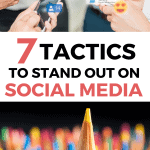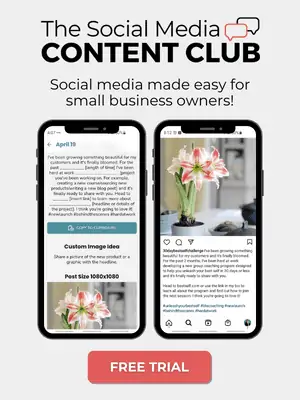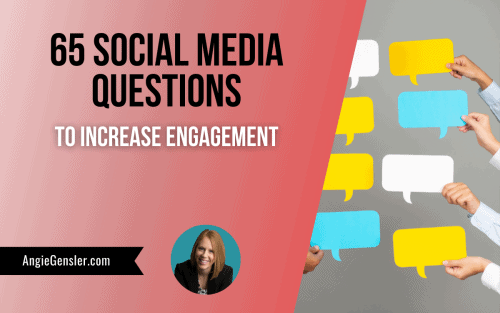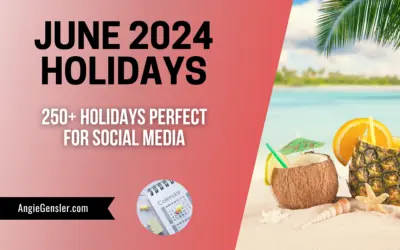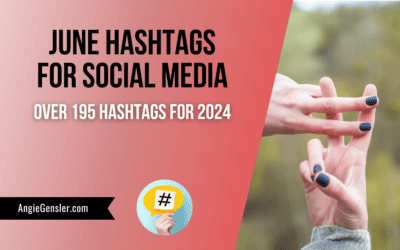
GUEST POST
Jessica Lowin is the Chief Editor of KrispCall. She has a wealth of computer, communications, and security experience. Through KrispCall, she aspires to make business communication safer, reliable, and more affordable.
In today’s crowded marketplace, social media has become an increasingly important tool for your business to differentiate itself and stand above competitors.
Social media allows you to create a unique and engaging brand voice, develop a strong online presence, and build relationships with your target audience.
Plus, with social media’s ability to track and analyze engagement metrics, you can make data-driven decisions to refine your social media strategy to better resonate with your audience.
However, most businesses have realized this social media strategy. So, simply maintaining an active social media presence isn’t enough. You need to incorporate numerous social media tips and tricks to stay on top.

This article will help you explore and understand some effective and unconventional social media tactics to stand out in a crowded market.

Understanding The Audience For Social Media Marketing To Stand Out in the Competition
There are several social media pain points for business, but the biggest of all has to be failing to generate enough reach and engagement that your business truly requires. Most of that usually comes from failing to know and cater to your actual target audience.
So you should always start your marketing campaigns with a solid understanding of your target audiences. Understanding your audience is crucial for thriving social media marketing. It allows you to create content and messages that are relevant, engaging, and valuable to your target audience.
Knowing your audience’s demographics, pain points, interests, and preferences always helps. It enables you to tailor your social media content and strategy to meet their needs and expectations better.

It not only increases the likelihood of your content being seen and shared but also helps build a stronger relationship between your brand and audience.
Ultimately, understanding your audience can lead to elevated engagement rates, increased brand loyalty, and more conversions.
However, it doesn’t come easy. It involves the following efforts:
Recognizing your target audience, creating buyer personas, and using audience insights to refine social media strategies.
Pinpointing your target audience for social media marketing is essential to reach the right people with your message. To identify your target audience, start by examining your existing customer or follower base. You can consider various demographics, including age, gender, location, and interests.
Use analytics tools to monitor social media engagement, reach, and conversion rates. It will help you understand which social media posts resonate with your audience and which do not. Use this information to refine your social media strategy and content to serve your target audience better.
After identifying your target crowd, the next step is creating buyer personas or customer profiles. It is a made-up representation of your model customer based on data and insights.

Use the information gathered during the target audience identification process to create customer personas. Include details of behavior patterns, goals, challenges, and pain points. It will help you create targeted and personalized content that speaks directly to your ideal customer and addresses their specific needs and concerns.
Finally, use audience insights to refine your social media marketing strategies. The insights tools within each social platform will provide invaluable insights into your audience’s behavior, including engagement rates, reach, and demographics.
Use this information to optimize your social media marketing tactics and strategy. For instance, if you notice that your audience is most active on Instagram, prioritize creating content for that platform.
By continually monitoring and analyzing audience insights, you can make data-driven conclusions that help you reach and engage with your target audience more effectively.
After mastering your audience base, you are now ready to explore some proven unconventional social media tactics for flourishing digital marketing and social networking. But first, let us briefly understand what it really means.
Unconventional Social Media Tactics
Unconventional social media tactics refer to non-traditional methods, strategies, or techniques used in social media marketing. They are creative and innovative approaches that stand out from the usual or traditional social media practices.
These tactics aim to attract and engage audiences uniquely and unexpectedly, leading to increased visibility, engagement, and conversions. Unconventional social media tactics can include anything from using memes, viral challenges, influencer collaborations, interactive content, user-generated content, and more.
These tactics require a deep understanding of the target audience and the social media platform to be effective.
Benefits of using unconventional social media tactics
Incorporating unconventional social media tactics into your marketing strategy can help you achieve your goals and reach your targeted mass in new and exciting ways. Below are some benefits of using unusual social media tactics in marketing.
1. Increased visibility and reach: Unconventional tactics can help your brand stand out from the rest, increasing visibility and reach among your target audience.
2. Enhanced engagement: These tactics often encourage more engagement and interaction with audiences, supplementing brand awareness and loyalty.
3. Improved brand perception: Your brand can break through the clutter of traditional marketing approaches and create a unique and memorable brand identity.
4. Cost-effective: Many unconventional tactics can be implemented with little to no cost, making them a cost-effective way to enhance a brand’s social media presence.
5. Increased conversions: Well-executed tactics can increase conversions and sales, as they can help you differentiate yourself and stand out in a crowded market.
Examples of unconventional social media tactics
Here are some popular brands’ successful marketing campaigns that used unconventional tactics to reach their target audience and generated good ROIs.
1. Snicker’s 500K impression with 1.05% CTR
The Snickers AdWords campaign is a great example of how an unconventional social media tactic can help a brand achieve its marketing goals. By thinking outside the box and using an unusual approach, Snickers was able to engage with its audience in a way that stood out from the competition and increased brand awareness.
The campaign featured a series of Google AdWords ads that targeted users who misspelled common search terms.

For example, if a user searched for “hungry” but spelled it “hunrgy,” they would be shown a Snickers ad with the tagline “You’re not you when you’re hungry.“
The campaign was highly successful, generating much buzz and engagement on social media. Snickers accumulated 558,589 Ads Impression with an outstanding 1.05% CTR to their specially-made website.
It was an innovative approach to advertising, as it used humor and relatable situations to connect with audiences in a new and unexpected way. The campaign was also cost-effective, as it only targeted users who had made a specific spelling mistake, resulting in a highly targeted audience.
2. ALS Ice Bucket Challenge’s $115 million donation
ALS Ice Bucket Challenge was a great example of an unconventional social media tactic that generated massive engagement and raised significant funds for a good cause.
It was a viral social media campaign that took place in the summer of 2014. It involved pouring buckets of ice water over participants’ heads and challenging others to do the same. It aimed to raise awareness and funds for ALS (amyotrophic lateral sclerosis), also known as Lou Gehrig’s disease.
How the ALS Ice Bucket Challenge started
Pete Frates started the challenge, a former college baseball player diagnosed with ALS in 2012. Frates and his family and friends began sharing videos of themselves completing the challenge on social media, and the trend quickly caught on, spreading across the globe.
The campaign was hugely successful on social media, with 17 million people participating and sharing videos of themselves completing the challenge. According to the ALS Association, the campaign helped to raise over $115 million in donations worldwide.
Unconventional Social Media Tactics To Stand Out In The Competition
Now let us explore the long-awaited unconventional social media tactics you can use in your social media campaign.
1. Use Humor
Humor is effective as an unconventional social media tactic for building connections with people. When used precisely, humor can help create a sense of relatability and approachability, making it easier for brands to connect with their audience personally.
Humor can also help make content more alluring and shareable, as people are likelier to share something they find funny with their friends and followers. Also, humor can help break through the noise and stand out in a crowded social media landscape. It is a valuable tactic for brands to differentiate themselves from their competitors.
Many brands have successfully used humor on social media to connect with their audience. Wendy’s is known for its witty and sarcastic Twitter account. Old Spice has a long history of using humor in its advertising campaigns. Similarly, Denny’s, Charmin, and MoonPie are some other brands that use humor to promote themselves.
Incorporating humor into social media content can effectively immerse your audience and humanize your brand. Before attempting to use humor, knowing your audience and what type of humor resonates with them is important.

While humor can be effective, it’s important to keep it appropriate and avoid anything that could be offensive or insensitive. Incorporating visual elements, such as memes or GIFs, can help to make your humor more memorable and shareable.
Don’t try to push humor if it doesn’t suit your brand’s personality or voice. Authenticity is key in incorporating humor into your social media content. Not all humor attempts will succeed, so it’s important to test and iterate your approach over time to see what resonates best with your audience.
By analyzing engagement metrics and followers’ feeds, you can continually improve your humor and better connect with your audience.
2. Leverage User-Generated Content
User-generated content (UGC) is any content produced and shared by customers rather than brands or organizations. This can include social media posts, product reviews, blog comments, and more.
UGC is often seen as a valuable marketing tool because it provides authentic and trustworthy content to help brands build trust with their audience. By encouraging users to create and share their content, brands can increase engagement, reach, and brand awareness.
One example of a brand that has successfully used UGC is Airbnb. The company created the #AirbnbPhotoContest, which encouraged users to share their best Airbnb photos on Instagram.
This campaign not only generated a large amount of high-quality content for Airbnb to use in their marketing efforts but also helped to add 172K followers on Instagram.
Another example is Coca-Cola’s “Share a Coke” digital campaign, which encouraged customers to share photos of personalized Coke bottles on social media using the hashtag #ShareaCoke. This campaign generated 3,500+ image custom content and 500+ video content of UGC, which helped to increase brand awareness and engagement.
UGC should align with your brand’s values and messaging and resonate with the target audience. You can encourage UGC by creating unique and engaging hashtags and running contests or challenges.
It can feature customer stories or testimonials and actively engage with users on social media. Giving credit and recognition to users who create UGC is also important, as this can help build trust and a sense of community.

You can offer rewards, such as discounts or exclusive access to products or events, to incentivize user-generated content creation. Contests and challenges can also incentivize UGC, with prizes awarded to the best entries.
You can also leverage the power of social proof by featuring user-generated content on your website and social media channels. It helps build trust and encourage others to create and share their content.
It is important to make the process of creating and sharing UGC as easy as possible by providing clear instructions and easy-to-use tools, such as branded filters or templates.
3. Collaborate with Influencers
Influencer marketing involves collaborating with individuals who have established credibility and trust with their audience, which allows them to promote products and services to their followers.
Influencer marketing effectively reaches your target audience, increases brand awareness, and drives sales and conversions. It offers several benefits, including improved brand credibility, increased engagement, and a higher return on investment (ROI).
One example of a brand successfully collaborating with influencers is Daniel Wellington. DW partnered with lifestyle & fashion bloggers on Instagram to promote its watches.
The campaign was a huge success, with Daniel Wellington increasing its annual revenues to around $200 million at present. The best part is DW started in 2011 with $15K.
Finding and working with influencers requires careful consideration and research. One of the first steps is to identify influencers who align with your brand ethics and target audience.
Once you have a list of potential influencers, evaluating their engagement rates, authenticity, and reach is important. Look at their content and followers to ensure their audience is genuinely interested in what they say.
When approaching influencers, be clear about your expectations and goals for the collaboration, and be willing to negotiate on compensation and creative direction.

Understanding influencer compensation and disclosure guidelines are also essential when working with influencers. The Federal Trade Commission (FTC) requires influencers to disclose their brand connection clearly.
Any compensation a brand pays to an influencer must be disclosed clearly. They should ensure that any sponsored content is clearly marked as such and that influencers are aware of and comply with the guidelines.
In terms of compensation, it’s important to have a clear agreement outlining the scope of work, deliverables, and payment terms. Compensation can take many forms, including monetary payment, free products or services, or a combination.
It’s important to negotiate compensation based on the influencer’s reach, engagement, and level of involvement in the campaign.
4. Create Interactive Content
Interactive content allows two-way engagement with the audience instead of passive consumption. Interactive content can take many forms, including quizzes, polls, games, calculators, and interactive infographics.
You get to relish several benefits of interactive content in social media engagement. First, the audience engages with interactive content at a higher rate, encouraging them to spend more time on your website or social media channels.
Second, it improves brand awareness and customer loyalty by providing an entertaining and memorable experience. Additionally, interactive content can help generate leads and collect valuable customer data, informing future marketing efforts.
Many brands have successfully used interactive content in their social media tactics. One example is Sephora’s Virtual Artist, which uses augmented reality technology to allow users to try on different makeup looks using their smartphone camera.
This interactive experience provides a fun and engaging way to shop for makeup and helps promote Sephora’s products and brand.
When creating interactive content, it’s important to focus on your target audience and tailor it to their interests and preferences. Start by identifying the goals of your interactive content, whether it’s to increase engagement, drive traffic, or generate leads.
From there, consider what types of interactive content will best achieve those goals. Remember that interactive content should be effortlessly usable, easy to navigate, visually appealing, and provide value to the user. Don’t be afraid to test and iterate your interactive content to see what works best.
You can consider quizzes, polls, calculators, games, and interactive infographics from several interactive contents. Quizzes and polls are great for increasing engagement and gathering valuable customer data.
Calculators and tools can provide useful information to users, such as mortgage or savings calculators. Games and interactive experiences can be entertaining and memorable, helping to improve your brand’s awareness and customer loyalty.
5. Engage in Social Listening
Social listening is the practice of monitoring social media platforms for mentions of a brand, product, or industry-related topic to gain insights about customer sentiment, opinions, and behaviors.
You can analyze social media conversations and trends to identify opportunities for engagement, address customer concerns and complaints, and track your brand reputation online.
Social listening also allows you to identify key influencers in your industry and understand your audience’s interests, which can help assemble marketing and product development strategies.
One example of a brand successfully engaging in social listening is Dove. The company has been praised for its “Campaign for Real Beauty,” which aims to challenge conventional beauty standards and promote body positivity.
Through social listening, Dove identified that many women felt overlooked by traditional beauty campaigns and sought a more inclusive approach. This led the company to create ads that featured real women of different ages, shapes, and sizes.
The campaign was a huge success and helped Dove establish itself as a brand that values diversity and authenticity.
To implement social listening, you should identify your objectives and the specific topics or keywords you want to monitor. You should also determine which social media platforms are most relevant to your audience and industry.
You should also be prepared to respond to customer feedback and engage in conversations promptly and authentically.
Various social listening tools are available, ranging from free options like Google Alerts to paid services like Hootsuite Insights, Brandwatch, and Sprout Social. These tools enable you to track mentions of your brand, industry, and competitors across multiple social media platforms, as well as monitor sentiment and track trends over time.
Some tools offer features like influencer identification, crisis management, and competitor analysis. It is important to select tools that align with your precise requirements and budget and regularly evaluate their effectiveness in achieving your social listening goals.
6. Repurpose Existing Content
Content repurposing means selecting your existing content, such as blog posts, live videos, or infographics, and recreating it across different channels and formats. You repurpose your content to increase your reach and engagement while saving time and resources on creating new content from scratch.
Repurposing content also enables you to encapsulate different segments of your audience, who may prefer different types of content or consume content on different platforms.
One example of a brand successfully repurposing content is Mailchimp. The email marketing platform created a series of podcasts called “Going Through It,” which featured conversations with women about challenging career moments.
Mailchimp repurposed this content by creating animated videos highlighting key moments from the podcast episodes. They shared these videos on several platforms like Instagram and Twitter and were accompanied by links to the full podcast episodes.
By repurposing the podcast content into visually engaging videos, Mailchimp increased engagement and reach with its audience while promoting its podcast series.

To repurpose your articles for social platforms, you should first identify the most popular and successful pieces of content you’ve created, such as blog posts, videos, or infographics. Then analyze your audience and determine which social media platforms are most relevant to their appeals and preferences.
From there, you can adapt your content into different formats and styles, such as creating short video clips, infographics, or social media posts with eye-catching visuals. It’s also important to tailor the messaging and tone of the content to fit the platform and audience and to experiment with different approaches to see what resonates best.
7. Use Social Media Advertising
Social media advertising offers brands several benefits, including access to a targeted audience based on demographics, interests, and behaviors. It also provides robust analytics and tracking tools that allow brands to measure the effectiveness of their campaigns and make data-driven decisions.
Additionally, social media advertising is usually cheaper than other forms of advertising, as brands can set specific budgets and only pay for clicks or impressions.
With social media advertising, you get several options, including sponsored posts, display ads, and video ads. Some social media platforms like Instagram and Snapchat offer advertising options like sponsored filters and lenses.
A successful example of a brand using social media advertising is Airbnb, which uses sponsored Instagram posts to showcase unique and stylish properties.
To create effective social media advertisements, you should first identify your target audience and tailor messaging and visuals to resonate with that audience. It’s essential to use eye-catching visuals and clear, concise copy emphasizing the benefits of the advertised product or service.

Use social proof, such as customer testimonials or ratings, to build trust and credibility with the audience. It’s also important to test and iterate on different ad formats, messaging, and targeting options to find what works best.
You can also use the Virtual Phone Number For Social Media to create, associate, and track your social media and content marketing performances. Virtual numbers offer several benefits, including better ROI tracking, in-depth data analysis, media integration, enhanced flexibility, and reliable privacy.
Assigning dedicated virtual numbers to each ad campaign helps you measure the effectiveness of your campaign and optimize for better results. On top of that, you can track the calls, gather quintessential data, and generate leads from these channels.
You can use the obtained data to measure the ROI of social media advertising and make data-driven decisions about where to allocate ad spend. Go for those virtual phone number providers that offer integrations with popular social media platforms like Facebook and Instagram.
Conclusion
We explored and learned about the seven unconventional social media tactics and their benefits with real-life examples of their successful implementations. Several successful brands use these social media tactics to boost their reach, sales, and conversions. Small business owners can also use the abovementioned unconventional tactics to grow their businesses.
Additionally, you can opt for virtual phone numbers in your business communications. These numbers offer several business benefits, including scalability, flexibility, and enhanced call management. On top of that, you can obtain use these numbers in marketing campaigns, gather customer information, measure campaign efficacy, and make data-driven decisions.
In addition, to stand on top of today’s crowded market, it’s essential to understand your audience and tailor your content to their preferences. Leverage user-generated content, partner with influencers, and be willing to try new and creative approaches.
Finally, authenticity and creativity are key, so don’t fear taking risks and experimenting. With the right approach, you can differentiate yourself and succeed in today’s competitive digital landscape.

GUEST POST
Jessica Lowin is the Chief Editor of KrispCall. She has a wealth of computer, communications, and security experience. Through KrispCall, she aspires to make business communication safer, reliable, and more affordable.
If you found this post helpful, please share it with others! It would mean the world to me.


